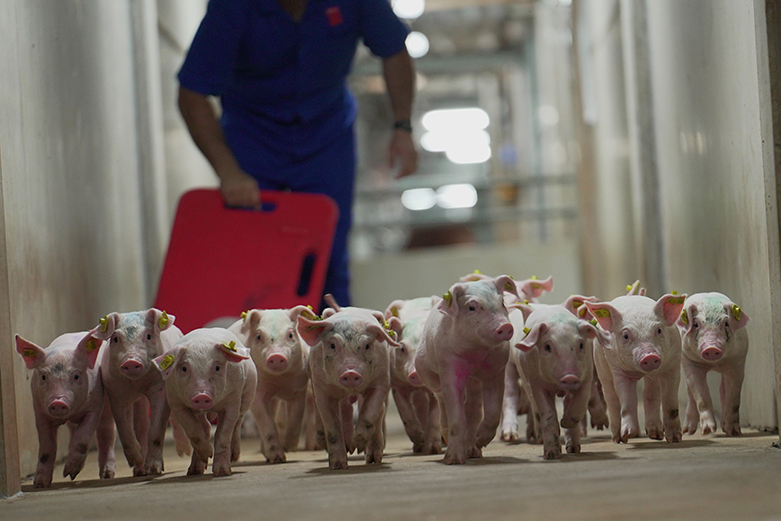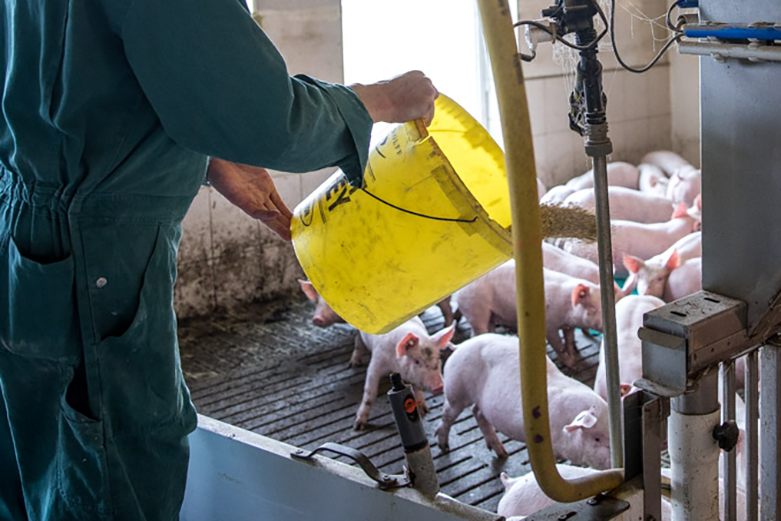WEANING OF PIGS: OPTIMAL MANAGEMENT AND NEW CHALLENGES – an 8-part series
- What happens at weaning
- Objectives at weaning for a sow
- Piglet management around weaning
- Management of piglets after weaning
- Feeding of the sow
- Piglet feeding at weaning
- Age at weaning
- Types of weaning according to the age of the piglet.
The authors:
Emilio Magallón Botaya – Veterinarian specialising in Economics and Pig Production.
Sara Beitia Delgado – Agronomist Engineer – La Almenara Farm
Pablo Magallón Verde – Technical Service PIC
David Roldan Feringan – Veterinarian-Granja La Almenara
Patricia Prieto Martínez – Veterinary Service Inga Food
Images provided by the authors
The environmental needs of the piglet at weaning are very specific and the environmental comfort ranges very narrow and have to be met regardless of the production system.
Management of piglets after weaning
The emergence of hyperprolific sow genetic lines has changed the management of sows and piglets in many ways. Weaning is one of the actions that has been most affected, especially with regard to the age and weight of the piglet. On the other hand, the health problems arising from increasingly large farms and the emergence of new pathogens at the end of the 20th century, made it necessary to look for alternatives to traditional pig production. This gave rise to the formulation of production in phases, in which we find the following stages:
- Phase I or reproduction.
This includes the breeding phase. Piglets are reared from breeders and boars until weaning. - Phase II or post-weaning.
Phase in which piglets are reared from weaning to transfer to the weaning section of the farm. - Phase III or fattening.
Phase from post-weaning or transition to the moment of sending the fattened pigs to the slaughterhouse.
Each of these phases is characterized by the different demands of the animals at a particular time in their lives.
Nursery types
- Nursery associated with breeder farms
Quite common system in pig production in which the post-weaning and the breeding phase are located on the same farm.
Two situations can be found:
- The first is that the grow-finishing or phase III is located elsewhere.
The weaned piglets are moved to the nursery barns and placed in different rooms each week of weaning. There is no mixing of animals of different ages. This system ensures that all weaned animals are of the same origin and reduces production costs by avoiding the transport of weaned piglets. - In the second , grow-finishing or phase III is on the same farm.
In this situation we are dealing with a closed cycle. It is more traditional and is associated with farms with a small number of sows.
- Transition or isolated post-weaning (isowean)
An isowean site is a phase II farm separated from both the breeder farm and the grow-finishing. The word is derived from “Isolated” and “Weaning”.
In an ideal isowean situation all piglets will come from a single farm and will all be of the same age.
This allows for an “all in/all out” management of the entire breeding flock, thus reaping the benefits from a health and logistical point of view. But the reality in the field is almost always different, and to fill the isowean barn in this way we would need a very large breeding farm, which is often not available. This results in “transitions” of different ages and different origins. The further we move away from the above-mentioned ideal situation the more problems will arise.
- Wean to finish
In this production system, the weaned piglets are moved to specially set-up farms, where the animals remain until they are ready for market and sent for slaughter.
These facilities must provide the necessary comfort for the early stages of rearing, with piglets weighing 6-7 kg, up to the finishing stage at around 110-120 kg.
They are equipped with heating systems and “multi-age” equipment with hoppers and drinking troughs that adapt to the different ages of the animals they house.
Advantages
It is a system with several advantages from an animal welfare point of view.
- Only two transports of the piglet during its lifetime (also an economic benefit).
- Adaptation to a new space is reduced.
Disadvantages
- The need for more skilled labour.
- Facilities are under-utilised in a large part of the rearing.
The main characteristics of the different types of post-weaning facilities are listed in table 1.
Table 1. Comparison of different types of post-weaners.

Design of weaning facilities
The aim of the facilities for weaned piglets is to enable the piglets to adapt to the new phase of their life and to meet the expected production targets.
Sizing
Several aspects will determine the size of the facility. Obviously, a traditional sow farm with associated nursery and grow-finishing capacities will not be the same as a wean-to-finish farm. It will also be decisive whether the facilities will receive piglets from a single farm, or whether they will receive piglets from more than one source. In the first case it will be necessary to have the appropriate post-weaning room according to the number of piglets produced in the breeder pen.
The European Directives establish minimum surface measures that these facilities have to have. Table 2 shows the area required for each animal according to its weight. These values are somewhat tight, and it is common practice to increase the space per animal by about 10 %.
We recommend a minimum of 0.25 m² per 20 kg piglet.
Table 2. Area required for each animal according to its weight.
| Piglet weight (kg) | Space (m²/animal) |
| <10 | 0,15 |
| 10-20 | 0,20 |
| 20-30 | 0,30 |
Sow housing
Once the sows are weaned, they are moved to the service area, where they can be housed in groups, where they will be inseminated later, once they come into oestrus. Sows weaned in group pens have a shorter weaning-breeding interval due to the interaction effect of sows developing first oestrus.
It is important that the sows have light, around 14-16 hours per day, with a power of 200 lux (figure 1).
Recently, new automatic oestrus detection systems have emerged to facilitate these processes. These are usually systems with probes or cameras, placed above the cages where the weaned sows are housed, which detect the individual movement of the sows in oestrus, as they have a more active pattern of movements. This data is recorded with a computer programme and by means of a programme algorithm determine the theoretical time of ovulation and indicate the optimum time of insemination for each sow.

Environmental needs of the piglet
It is essential for maximum productivity and profitability of pig farms to provide the best possible environmental conditions for weaned piglets. This means controlling the different parameters as precisely as possible. The animals must be provided with the ideal temperature, humidity, and ventilation (table 3) for their welfare, and we must also be able to monitor them as well as possible for their correct implementation.
Table 3: Temperature and ventilation recommendations throughout the post-weaning phase according to weaning day and season. Adapted from Queiles and Hevia (2006).

Number of post-weaning places per breeding sow
Traditionally, 3 post-weaning places were needed per sow place, but this was for productions of around 20-25 piglets per sow per year. With the current productivities we should go to a minimum of 4 places for productivities of 25-30 piglets, and above 30 weaned piglets we will need 5 post-weaning places per sow place to comfortably manage the post-weaning, and to be able to guarantee around 5-6 weeks of stay in the post-weaning.
This series of articles was first published in the professional journal SUIS.



